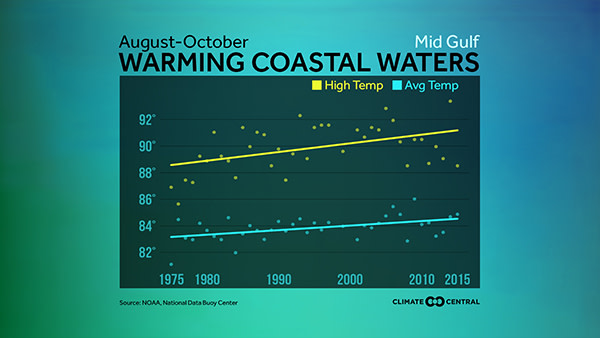To serve as a reminder, Hermine arrived right at the start of the most active part of hurricane season. The peak of hurricane season coincides with the time of year when ocean temperatures are at their warmest. This week, we look at sea surface temperatures along the coast using data from the NOAA National Data Buoy Center. Both the maximum and average sea surface temperature during hurricane season have risen.
When we talk about a warming climate, we often focus on air temperatures. Only 7% of the excess energy trapped in the climate system by increasing greenhouse gases goes into the land, air, and ice, though, while 93% of that energy goes into the oceans. The water temperature rise is slow and steady, as it takes 4 times more energy to raise the temperature of water compared to the air.
Large sections of the global oceans have warmed 1-3°F during the last century, with some buoy locations having a more dramatic rise recently. Of the Gulf of Mexico buoys analyzed, the average water temperature from August through October has risen 1-2°F in the last 40 years. The buoys analyzed in the Atlantic have warmed even more during that three-month period — 2-4°F in the last 30 years. While at single buoys the water may have warmed faster or slower than other locations, globally, there is a clear trend towards hotter sea surface temperatures.
Warmer water fuels hurricanes, and not surprisingly, the average number of major hurricanes — those Category 3 or higher — has increased in the Atlantic basin since the 1970s. Globally, climate models project that there will likely be an increase in the wind speed and rainfall intensity of the strongest hurricanes (aka tropical cyclones), even though their frequency may remain unchanged or even decrease by the end of this century. However, the extent of these effects from climate change will vary by region.
Even with no increase in storm strength, the damage from storm surge is already worse because warming waters are also contributing to sea level rise. Seas are projected to rise up to at least another 3 feet by the end of the century, only adding additional water to any tropical system’s dangerous storm surge.
